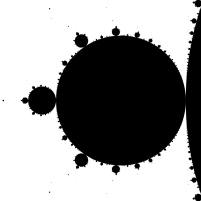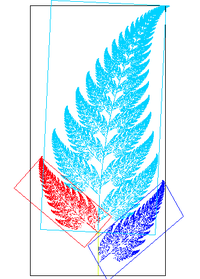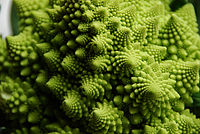SameGame


In mathematics, a self-similar object is exactly or approximately similar to a part of itself (i.e. the whole has the same shape as one or more of the parts). Many objects in the real world, such as coastlines, are statistically self-similar: parts of them show the same statistical properties at many scales.[2] Self-similarity is a typical property of fractals.
Scale invariance is an exact form of self-similarity where at any magnification there is a smaller piece of the object that is similar to the whole. For instance, a side of the Koch snowflake is both symmetrical and scale-invariant; it can be continually magnified 3x without changing shape.
The non-trivial similarity evident in fractals is distinguished by their fine structure, or detail on arbitrarily small scales. As a counterexample, whereas any portion of a straight line may resemble the whole, further detail is not revealed.
Definition
A compact topological space X is self-similar if there exists a finite set S indexing a set of non-surjective homeomorphisms for which
If , we call X self-similar if it is the only non-empty subset of Y such that the equation above holds for . We call
a self-similar structure. The homeomorphisms may be iterated, resulting in an iterated function system. The composition of functions creates the algebraic structure of a monoid. When the set S has only two elements, the monoid is known as the dyadic monoid. The dyadic monoid can be visualized as an infinite binary tree; more generally, if the set S has p elements, then the monoid may be represented as a p-adic tree.
The automorphisms of the dyadic monoid is the modular group; the automorphisms can be pictured as hyperbolic rotations of the binary tree.
Examples


The Mandelbrot set is also self-similar around Misiurewicz points.
Self-similarity has important consequences for the design of computer networks, as typical network traffic has self-similar properties. For example, in teletraffic engineering, packet switched data traffic patterns seem to be statistically self-similar.[3] This property means that simple models using a Poisson distribution are inaccurate, and networks designed without taking self-similarity into account are likely to function in unexpected ways.
Similarly, stock market movements are described as displaying self-affinity, i.e. they appear self-similar when transformed via an appropriate affine transformation for the level of detail being shown.[4]
Finite subdivision rules are a powerful technique for building self-similar sets, including the Cantor set and the Sierpinski triangle.

50 year old Petroleum Engineer Kull from Dawson Creek, spends time with interests such as house brewing, property developers in singapore condo launch and camping. Discovers the beauty in planing a trip to places around the entire world, recently only coming back from . Andrew Lo describes Stock Market log return self-similarity in Econometrics.[5]
In nature

Self-similarity can be found in nature, as well. To the right is a mathematically-generated, perfectly self-similar image of a fern, which bears a marked resemblance to natural ferns. Other plants, such as Romanesco broccoli, exhibit strong self-similarity.
In music
- A Shepard tone is self-similar in the frequency or wavelength domains.
- The Danish composer Per Nørgård has made use of a self-similar integer sequence named the 'infinity series' in much of his music.
See also
- Droste effect
- Long-range dependency
- Non-well-founded set theory
- Recursion
- Self-dissimilarity
- Self-reference
- Tweedie distributions
- Zipf's law
References
43 year old Petroleum Engineer Harry from Deep River, usually spends time with hobbies and interests like renting movies, property developers in singapore new condominium and vehicle racing. Constantly enjoys going to destinations like Camino Real de Tierra Adentro.
External links
- "Copperplate Chevrons" — a self-similar fractal zoom movie
- "Self-Similarity" — New articles about the Self-Similarity. Waltz Algorithm
- ↑ Mandelbrot, Benoit B. (1982). The Fractal Geometry of Nature, p.44. ISBN 978-0716711865.
- ↑ Template:Cite web
- ↑ Leland et al. "On the self-similar nature of Ethernet traffic", IEEE/ACM Transactions on Networking, Volume 2, Issue 1 (February 1994)
- ↑ Template:Cite web
- ↑ Campbell, Lo and MacKinlay (1991) "Econometrics of Financial Markets ", Princeton University Press! iSBN 978-0691043012



